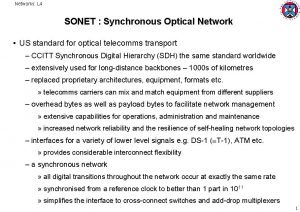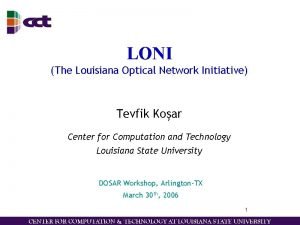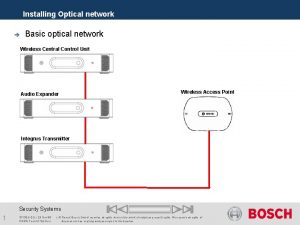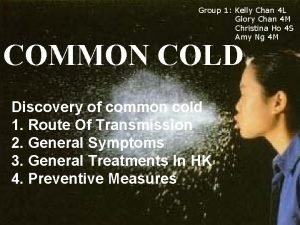Future Optical Network Architecture Vincent Chan Asuman Ozdaglar















- Slides: 15

Future Optical Network Architecture Vincent Chan, Asuman Ozdaglar, Devavrat Shah MIT NSF FIND Meeting Nov 2006 Vincent Chan 1

Optical Networks • WDM, Optical amplifiers high rates, long reach multicasting • Optical routing and switching power localization, narrow casting, long reach, high utilization? • Increase in capacities (major difference between fiber bandwidth and link rates) decrease in cost? Can we trade bandwidth utilization for lower cost ? Perhaps but with new architectures! Vincent Chan 2

Optical Network – Near future • Optical switching – GMPLS bypass, load balancing, … • Packet processing cost dominates Vincent Chan 3

• 1 st disruptive technology - WDM fiber links • 2 nd disruptive technology - optical switching • 3 rd disruptive technology - direct optical access • 4 th disruptive technology - new transport mechanisms Subscriber cost e-switched architecture Computing Optical switching Electronic access 10 102 103 104 105 106 Optical network evolution/revolution and disruptive technologies 1 Fiber trunks Increasing line speeds Optical access Dispersion managed Limit of WDM/optical switching technology ? 1970 1974 1978 1982 1986 1990 1994 1998 2002 2006 2010 2014 2018 2020 Can we trade bandwidth utilization for lower cost ? Vincent Chan 4

Optical Networks Wide area CO Metro/access Feeder • Transport mechanisms –flow switching AN Distribution Tree AN • Physical and logical architecture AN • Routing: separate IP and optical control planes • Very fast dynamics < 100 m. S AN Distribution Rings AN Access Node • Scalable • Low cost Distribution bus Vincent Chan 5

Candidate Transport Mechanisms scheduler WAN LAN X X mux OXC X w dedicated wavelength channels WAN LAN X X mux X Tell-and-Go / burst switching (Ta. G) OXC X w dedicated wavelength channels X Optical flow switching (OFS) WAN MAN router LAN MAN WAN router LAN X LAN OXC X w dedicated wavelength channels MAN Generalized multiprotocol label switching (GMPLS) Vincent Chan MAN router MAN WAN router WAN MAN Electronic packet switching (EPS) 6

Optical Flow Switching and Bypass User 1 Network control . . . Router 1 User 2 . . . Router 2 Router 3 WDM layer • End-to end (user-to-user) flows bypassing routers • Very challenging IP/optical control planes (<100 ms) • Architecture provide multiple services including overlays. • Supports virtualization • Security? Optical infrastructure isolation Vincent Chan Decreasing cost to scale 7

The Optical Network Architect’s Problem T Given dynamic traffic matrices • When failure occurs or traffic changes, tunable XCR & OXC take care of maintaining or providing new logical connection via RWA Derive desired logical topology (multiple, dynamic) Design sensible fiber plant topology Joint optimization • When needed physical topology fixed part of LTD can be redone to get better connections when traffic changes • Physical topology is made changeable by OXC, slow or fast. Vincent Chan Logical topology realized by routing and wavelength assignment, RWA (dynamic part of LTD) Design physical topology – fixed part of LTD 100 ms can be as fast as 5 ms + 1 roundtrip time 8

Cost comparison of transport mechanisms This plot assumes that there are 10, 000 users per MAN, including both active and dormant users. It is assumed that 10% of the number of users in each MAN are active (i. e. transmitting) at any instant in time. It is also assumed that MAN and WAN routers run at 20% utilization. Vincent Chan 9

Large reconfigurable optical switches as architecture building blocks • Large optical switches used for aggregation and multi/narrow-cast • Reconfigurable at m. S rates • Allows dynamic group formation for active flow switching users • Optical multicast create new reachable regions with networking coding • Simplifies hardware Vincent Chan 10

Routing & Wavelength Assignment and Flow Control Algorithms • Two main challenges in the design of routing and flow control mechanisms: – Design of distributed asynchronous algorithms that work with local information – Nonconvexities due to integrality constraints, and nonlinear dependencies on the lightpaths owing to fiber nonlinearities. • Previous Work: RWA problem formulated as a mixed integer-linear program (computationally very hard) • Two approaches: – Multi-commodity flow formulation – Statistical techniques for routing, scheduling and admission control Vincent Chan 11

Multi-commodity Flow Formulation • Optimal multi-commodity flow formulation • fl : Total flow of link l • The link cost function convex and monotonically increasing – Keep link flows away from link capacity – The link cost function piecewise linear with integer breakpoints • We proved in some topologies that the relaxed problem has an integer optimal solution and provided an efficient algorithm to find it. Vincent Chan 12

Algorithms based on state statistics • Algorithms need to operate at the granularity of flows • Primary network layer tasks in flow-level network – Admission control • Buffering, admitting or dropping flows arriving at network • Interacts with Routing and Scheduling to make decisions – Routing and wavelength scheduling • Assign rates to end-hosts at network layer based on available statistical information • Given rate requirement by interacting with routing, it allocates physical resources such as lightpaths and wavelengths to end-hosts Vincent Chan 13

Trade-off between performance, complexity and network dynamics • The algorithms utilize statistical information about network – Dynamics of network affects the confidence in statistical information – Complexity of feedback can reduce effect of dynamics Trade-off between complexity and effect of dynamics • The confidence in statistical information affects performance – Less accurate statistical information will lead to wastage of resources • Thus, for algorithms operating in such network – Trade-off between performance, complexity and network dynamics plays an important role in design • Traffic statistics collection algorithms are essential in the network performance Vincent Chan 14

• ‘New technology’ • New transport mechanisms • New architectures • New applications • Grows faster than Moore’s Law • New opportunities Vincent Chan 15
 Bé thì chăn nghé chăn trâu
Bé thì chăn nghé chăn trâu Vincent chan mit
Vincent chan mit Future perfect simple and future continuous
Future perfect simple and future continuous Future perfect simple continuous
Future perfect simple continuous Asuman reyhan kurt
Asuman reyhan kurt Pınar özdemir 1991 türkiye güzeli
Pınar özdemir 1991 türkiye güzeli Diapedez
Diapedez Asuman gölgeli
Asuman gölgeli Asuman doğaç
Asuman doğaç Asuman gölgeli
Asuman gölgeli Asuman reyhan kurt
Asuman reyhan kurt Asuman sunguroğlu
Asuman sunguroğlu Karabk
Karabk Optical correction in greek architecture
Optical correction in greek architecture Sonet synchronous optical network
Sonet synchronous optical network Louisiana optical
Louisiana optical





























